
Dualities exist everywhere. From summer and winter to masculine and feminine, these opposing and interconnected forces both drive and sustain the universe. Duality pretty much defines your conventional reality whereas the opposite of duality which is ‘non-duality (oneness)’ defines the absolute reality. In your spiritual journey, it is important that you understand both these concepts on a deeper level.
In this article, lets understand duality via symbolism associated with it. The concept of duality has been mirrored in various spiritual and religious symbols across the globe. The following is a list of 25 symbols of duality and their associated meanings to help you raise your consciousness and find balance, peace, and harmony in your life today.
25 Symbols of Duality & Dualism
1. Number 2

The number two represents duality in its purest form — the concept that each person, idea, and functional mechanism of the universe must exist in two opposing states to retain balance. We can liken it to a balance scale that must have two dishes to function properly.
When you examine the world, it makes sense. The day only arrives after the night. The masculine must be born of the feminine. The summer harvest cannot come without the winter frost.
In the tarot deck, a number two calls on the duality of opposition and choice. One must lose for the other to win, and one must be abandoned for the other to be chosen. In Buddhism, the number two indicates the duality of samsara and nirvana, or the earthly vs. heavenly states of being. In Taoism, it reflects the opposing forces of yin and yang.
2. Yin & Yang

You’ve undoubtedly seen the popular yin-yang sign, but do you know its real significance? This symbol represents the Chinese philosophical idea behind the creation and maintenance of the universe. The philosophy itself is one of dualism, suggesting that all opposing forces both uphold and rely on one another.
The yin and yang are energies borne of one initial chaos, splitting to form two polarized yet complementary forces. The yin is a more introverted and feminine energy, while the yang is extroverted and masculine. Alone, each would be incapable of sustaining life. Together, they create a perfectly-balanced and interconnected energetic state known as chi.
3. Double Spiral

The double spiral is a powerful Celtic symbol of duality which represents the intricate balance that exists between two opposing forces.
The spiral on the right side runs clockwise starting from the inside and going out. It represents all of creation arising out of a single source (or point of origin). On the other hand, the spiral located on the left side runs counter clockwise starting from the outside and going in. It represents destruction or everything going back to the one source. The balance between these two opposing energies is what keeps the universe alive.
Also here’s a list of 22 Spiral symbols & their deeper symbolism.
4. Double Fish

The twin fish symbol which depicts two fishes swimming in opposite directions represents the opposing energies that form the basis of all creation. The fishes also represent the energy of the mind (thought) and the heart (emotions) or the left and right hemispheres of the brain that have to come into alignment for one to experience higher consciousness and awakening.
Similarly, a fish swimming in water in itself symbolizes duality as water represents consciousness or spirit and the fish represents creation or physical manifestation.
5. Ouroboros
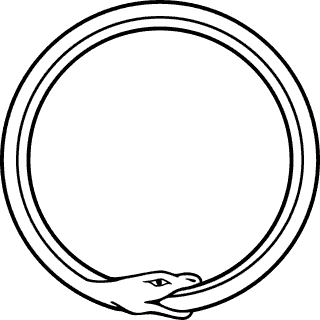
Originating in ancient Egypt, the Ouroboros symbol of the snake eating its own tail is a classic depiction of duality now popular around the world. The Ouroboros is drawn as an unbroken circle. It represents creation (the snake consuming to survive) and destruction (the tail being consumed) both happening at the same time. It also represents eternity and the endless cycles of the universe. Creation and destruction, birth and death, all are infinite and necessary dualisms.
Life is the opposite side of death, and creation is the opposite side of destruction. If you examine them closely, you’ll see that every dualism in the cycle complements its opposite perfectly. Nothing may be created without something else being destroyed. For example, you cannot build an empire without destroying previous social structures. And you cannot have life without death, or the world would become much too crowded and unbalanced.
6. Magpie
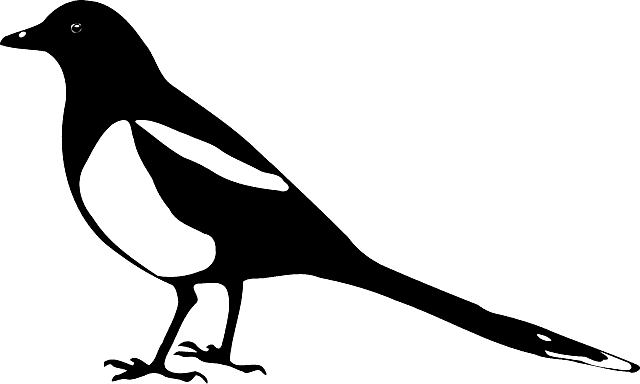
Magpies are striking birds. Their black and white feathers are stark polar opposites, and their spiritual meaning is based on their looks. The magpies’ coloring represents the duality of our nature and the inner forces of good and evil present in all of us.
Magpies are also bringers of reconciliation, mirroring the connected nature of the universe and the coming together of opposite forces. Their character is brave, hearty, and stalwart—yet even as they display such extroverted characteristics, the magpie remains soft and beautiful to look at, a classic duality.
7. Buddha
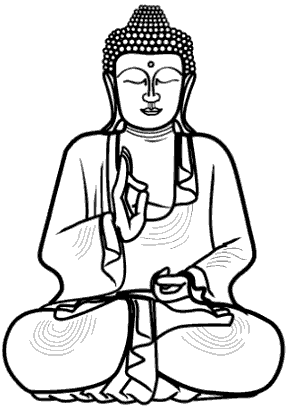
Especially among those who subscribe to the Dvaita school of thought, the figure of Buddha is reflective of the duality so intrinsic to their spiritual practice. The Buddha is one who has reached enlightenment, going through many different cycles of reincarnation.
As such, the Buddha is a symbol encompassing all those cycles and all the dualities which support them. Buddha is masculine and feminine, strong yet soft, a teacher and a student. We can all see ourselves in the Buddha because he symbolizes each side of all things.
8. Thread

At first glance, the lowly thread is nothing special. But looking deeper, we can see exactly how this humble twine represents a larger universal duality. Alone, a single piece of thread is practically useless. It is weak, incapable, and fragile.
But thread becomes incredibly strong when woven into cloth. Just like a thread, we humans can be weak when standing alone. But when we join together as a force, we can achieve great things. We become a capable force to be reckoned with, representing the duality of one vs. many.
9. Vesica Pisces
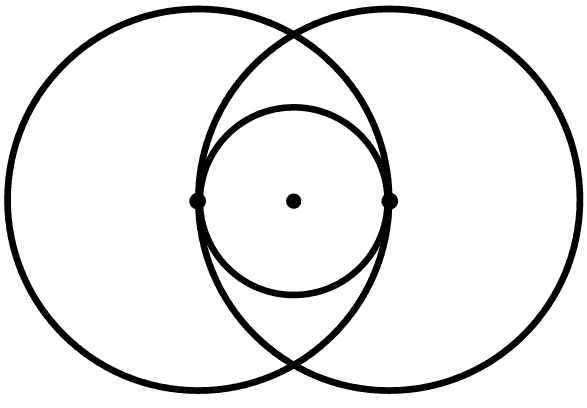
The Vesica Pisces is a Pythagorean symbol that depicts two circles intersecting in such a way that the center of each circle lies on the perimeter of the other. In spiritual terms, it represents the intersection of the spirit and material worlds which is the basis of all creation. The intersection forms a gateway or sacred portal (cosmic womb) through which creation can take place. It can also be used to represent the heart and the mind, masculine and the feminine and other dualities present in the universe.
10. Eiwaz Rune

A vital Norse symbol, the Eiwaz Rune represents the meeting of dual worlds and the cyclic nature of the universe which allows it to flourish throughout eternity. Eiwaz Runes were first created from the yew tree. As an evergreen tree, the yew is a special symbol of duality representing both life and death. It characterizes how these two states of existence rely on each other.
As the roots of the tree reach deep underground while its branches rise up towards the sky, the yew is also a gateway. It acts as a bridge between the states of life and death, or heaven and earth. The Eiwaz Rune itself symbolizes the two polar sides of these extremes, encouraging a relationship of balance and harmony between them both.
11. Chakana (Inca Cross)
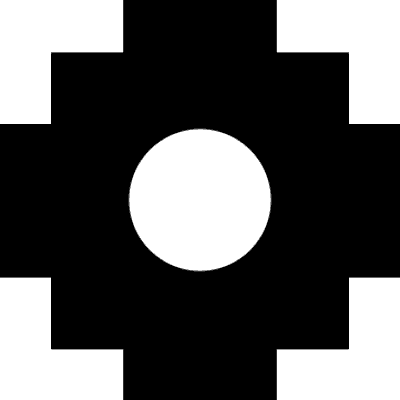
Used widely throughout the ancient Inca empire, the Chakana still holds meaning today. An all-encompassing symbol of duality, the cross represents the entire universe and all the life it contains. All dynamic relationships and cyclic opposites within the universe are represented in the Chakana—the seasons, the genders, geography, and more.
Aesthetically, the Inca Cross is a perfect depiction of symmetry. The upper part is lightly shaded, while its lower half remains dark. This represents a concept known to the Incas as Yanantin, or the reciprocal energies that make up the world. The hole in the Chakana’s center represents the circle of life and the city of Cusco, which the Andeans dubbed “the navel of the Inca Empire” before Spanish colonists arrived.
12. Dingo

This infamous canine companion found in Australia defies categorization, leaving many scientists befuddled by the duality of its nature. Neither quite wild nor quite domesticated, the dingo lives on the edge of both and can adapt to each situation with relative ease.
Featuring heavily in Aboriginal folklore, dingoes appear in both Dreaming and Waking realms—symbolizing their ability to pass through the physical and spiritual spaces. They are seen as guardians of these realms because of their special abilities to flourish in both, and so represent the harmony and balance between this world and the next.
13. Gingko Tree

Gingko trees are one of the oldest species around. The Chinese people recognize the power of these trees, using them to symbolize all opposing natural forces. Gingkoes celebrate the harmony that comes from duality, and serve as living evidence that survival can be achieved through balance.
Gingko trees represent the yin and yang so important to Chinese culture. They can symbolize dual energies like masculine and feminine, or strength and vulnerability. The Gingko’s deep roots and high branches can also represent different spiritual planes like heaven and earth, or parts of the natural cycle like day and night.
14. Satkona
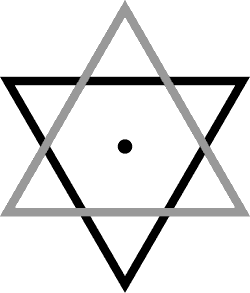
Satkona is an ancient Hindu symbol of dualism that depicts two superimposed triangles, one facing upward and the other facing downwards. The upward facing triangle represents Shiva (or masculine energy) and downward facing triangle represents Shakti (or feminine energy). The combination of these two energies creates the universe. The triangles also represent the balance between the spiritual and physical realms as well as the balance between the form (matter) and the formless (spirit).
15. Serpent

The serpent is considered a symbol of duality because of its ability to represent both the male and female principles. When stretched out, it represents the male principle, whereas when curled up, it represents the female principle. It also represents the dualism of good and bad. Similarly, snake venom is poisonous but can also be used as an antidote. Also, a snake draws both fear as well as fascination.
16. The Cross
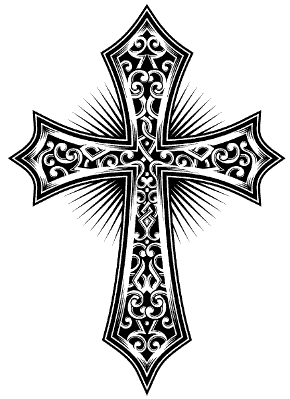
The cross is a symbol of duality as it represents that descent of spirit (formless) into matter (form). The horizontal bar represents spirit (the spiritual realm) and the vertical bar represents physical matter (the material realm).
17. Sri Yantra

The SriYantra is a powerful spiritual symbol that represents duality becoming non-duality (oneness) and vise versa. It depicts a series of overlapping upward and downward facing triangles with the central point representing oneness. Meditating on this symbol is said to facilitate harmony and balance within your body, mind and spirit.
18. Eagle’s tail feather

The tail feather of a golden eagle has two distinct colors – light and dark. The light and dark colors depict duality in all things – darkness and lightness, feminine and masculine, summer and winter as well as spirit and matter.
19. Hunab Ku
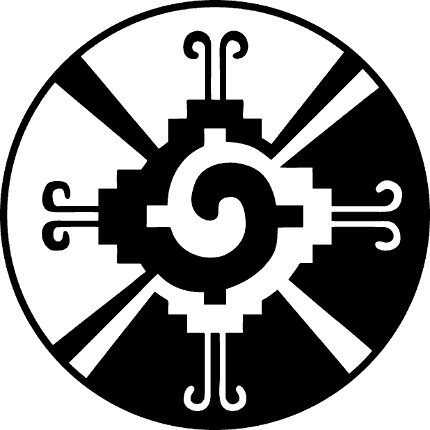
Hunab Ku also known as ‘the galactic butterfly’ is a Mayan symbol that is similar to Yin/Yang and represents duality between opposing energies and the balance that exists in the universe. It also represents duality converging into non-duality (oneness) or one eternal consciousness.
20. Shiva’s eye shell

The Shiva’s eye shell comes from a specific type of snail that is found off the coast of Thailand and New Zealand. The shell is actually an Operculum or a door that is used to close the opening of the main shell in which the snail lives. The fact that the Shiva’s eye shell is a door makes it a symbol of duality (as we discussed earlier).
Similarly, the shells also carry a pattern that resemble an eye on the outside and a beautiful spiral design on the inside. This is why the shell is used to represent Hindu God Shiva’s eye or the third eye chakra. This chakra is associated with duality as it acts as a gateway between the physical and spiritual realms. It helps you see duality contained within non-duality and non-duality expressing itself as duality.
21. Sun and the Moon

The Sun and Moon are perfect symbols of duality. The sun symbolizes strength, power, light, warmth, work and masculine energy, whereas the moon symbolizes calmness, beauty, love, relaxation and feminine energy. Both these forces are different but interconnected and crucial for survival of life on earth.
22. Door

A symbol of duality can be as subtle as a simple door. The door is an object which functions in two opposite ways—an entrance and an exit. It is a threshold to enter one room while leaving behind another. It acts as both a barrier between physical spaces and a tool to enter them.
A locked door can also represent opposing physical or emotional states. It ensures the safety of those inside, but keeps others outside and vulnerable. Oppositely, it could represent the duality of oppression. The door acts as a way to imprison someone or something, while ensuring the mastery of the one who holds the key.
23. Bear

The bear is generally characterized as a ferocious animal. If you see one in the wild, you tend to run the other way. However, there is another side to the bear’s personality. These creatures generally enjoy lazing around, eating sweet honey, and playing together with their young.
In this way, the bear represents the duality present in all of us. While not as obvious as the bear, humans also have two sides to their personality: light and dark, angry and happy, protector and playmate. All these facets of human nature are necessary for survival, and that is why we (and bears) have managed to stick around for so long.
24. Zebra

The zebra has a dual color tone with an almost identical number of black and white strips. The stripes are a reminder of the presence of light and dark personalities that exists within you. You need to become conscious of these personalities and bring them into balance so you can maneuver your life in the right direction.
25. Blue Heron

Owing to its beautiful color and various spiritual meanings, the Blue Heron is a one of the most widely-celebrated birds around the world. This tenacious hunter reigns supreme over land and sea, able to cross between dual realities of nature.
The heron straddles both planes of existence as it flies, easily traversing them and switching focus as necessary. It reminds you to exist in the spiritual world as well as the physical. To be like the heron is to maintain every aspect, keeping balance in our lives instead of focusing too strongly on one thing for too long.
Conclusion
Duality is a vital force present throughout the universe. It personifies harmony within the self and in the environment, representing twin forces of opposition which rely on each other to form our natural world. When you feel overwhelmed by a single aspect of your life, focus on these symbols of duality to find peace and balance again.







